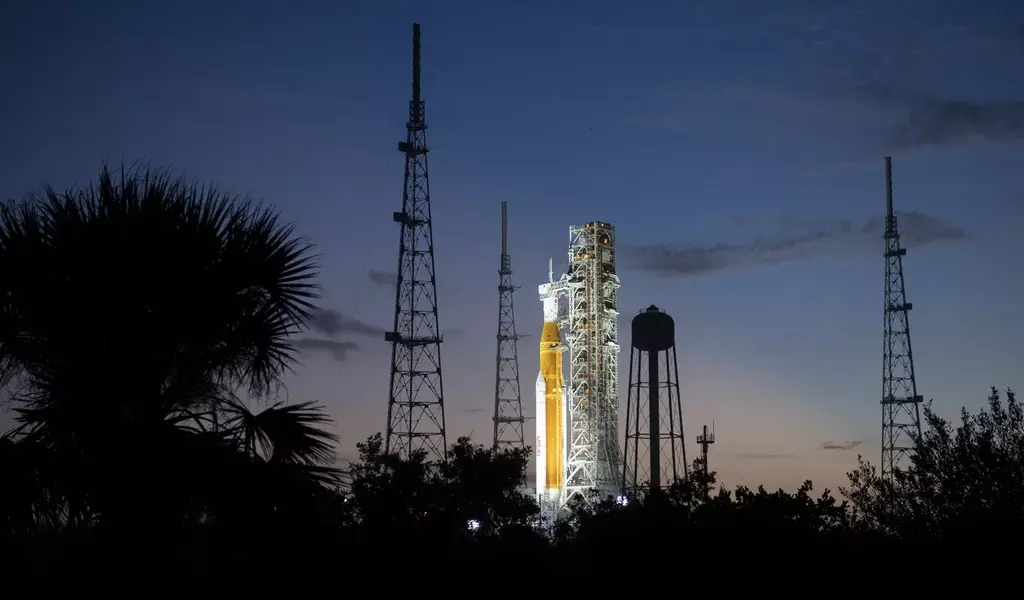(CTN NEWS) – CAPE CANAVERAL, Despite slight damage from Hurricane Nicole, the Artemis I mission crew intends to try to launch the big moon rocket again this week.
On Wednesday, November 16, a two-hour launch window for liftoff starts at 1:04 a.m. The Space Launch System rocket’s first mission will be a test orbit of the moon.
Jim Free, the associate administrator for NASA’s Exploration Systems Development Mission Directorate, stated during a press conference on Friday, “We have some work to do.”
According to him, NASA officials likely would not have rolled the SLS rocket and Orion crew capsule back out to the launchpad if Nicole had become a Category 1 hurricane.
Hurricane Ian hit Florida in September, delaying the rocket’s third launch attempt after problems with fuel leaks prevented the first two launches.
Nicole was the first hurricane to affect the United States in November almost in 40 years. While the storm off the East Coast was still nameless, SpaceX chose to roll out the SLS rocket to the launchpad on November 4.
According to Free, Nicole left several important topics unresolved. Ground crews will “snip off” some caulking on the Orion spacecraft.
One of the SLS rocket engines had a tear in the rain cover, and water seeped into the crew access arm, the runway astronauts will use to board the Orion spacecraft. Additionally, an electrical connector needs to be fixed.
Windy Conditions
Before Nicole made landfall, the Artemis I mission team was concerned about wind gusts and debris. According to a NASA official release, the rocket is built to endure winds of up to 85 miles per hour.
“Despite wind gusts up to 82 miles per hour at 60 feet being measured by launch pad sensors, the rocket can handle this. We anticipate releasing the vehicle for those circumstances soon.” Free stated.
The 467-foot elevation of the lightning towers experienced wind gusts of up to 100 miles per hour; a NASA representative verified Thursday night.
On one of the lightning towers around the rocket, sensors at 5:15 a.m. on Thursday recorded wind speeds of 75 mph, with gusts topping 100 mph. On the National Weather Service website, data from a few of the sensors that NASA and the US Space Force own is accessible.
According to that website, the sensor collecting those data is 7 feet above the ground. It was incorrect, a meteorologist from the Melbourne prediction office of the National Weather Service told CNN.
The sensor’s actual height is 230 feet, which should yield precise data for the kinds of gusts that the 322-foot-tall rocket experienced.
However, according to Free on Friday, none of the NASA readings went above acceptable levels.
Free added, “We never saw anything above those limits,” adding that despite the wind data, the SLS rocket had more than enough leeway to withstand the gusts.
The storm was predicted to produce steady winds of roughly 29 miles per hour with gusts up to 46 miles per hour when officials opted to move the SLS rocket out to the launchpad.
But on Monday, the storm developed into a named system three days after the rocket was delivered to the launch pad.
According to Free, the team felt the launch pad was the safest position for the rocket to weather the storm because returning to the Vehicle Assembly Building was too perilous in the heavy winds.
Moving the massive moon rocket from the launchpad to the vehicle assembly building takes a lot of effort. The move typically requires three days of preparation before it can be executed, and the mission team can only undertake so many rollbacks.
In ideal circumstances, the plodding 4-mile journey aboard a massive NASA crawler from the Apollo period takes 10 to 12 hours. The rocket could only withstand sustained winds of no more than 46 miles per hour if it had to be rolled back when a storm developed.
The Artemis I programme of NASA seeks to send people back to the moon for the first time in 50 years.
And the Artemis I mission, which is expected to be the first of many, will begin the process by testing the rocket, spacecraft, and all of the subsystems to ensure astronauts can travel safely from and to the moon.
RELATED CTN NEWS:
Apple’s Mac Pro 2013 Outperforms M2 Silicon
Apple Sued for Tracking Users’ Activity Even When Settings were off
2-In-1 Lenovo Yoga 7i 14 Review: Great Performance, Mainstream Looks






